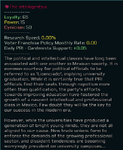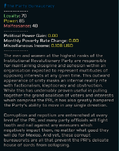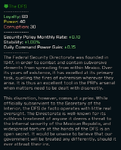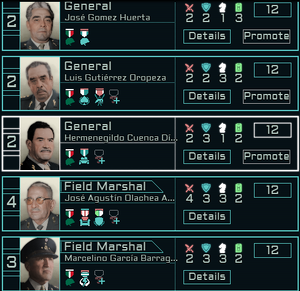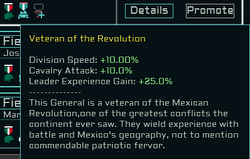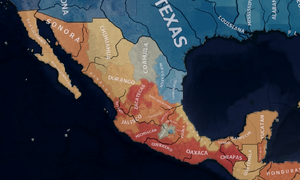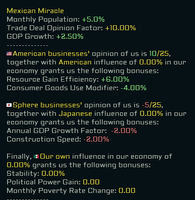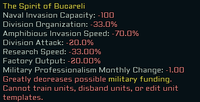United Mexican States
The United Mexican States is a country located in the southern part of North America. It borders the United States in the north; and Belize and Guatemala to the south-east. Its capital and largest city is Mexico City also known as the Federal District. Mexico is a neutral nation that trades with the Greater East Asia Co-Prosperity Sphere, which includes the Empire of Japan. While also maintaining strong diplomatic and commercial relations with the United States.
Mexico is a federal constitutional democracy composed of 30 states, two territories and the Federal District. The head of state is a elected president that serves for one term of six years, the president in 1962 is Adolfo López Mateos who is 3 years into his presidency, the number two is the Secretary of Interior Gustavo Díaz Ordaz who serves for the same amount of time as the president.
History
The Revolutionary Period (1908-1934)
The Porfiriato (1906-1910)
The United Mexican States from the years of 1876-1910 were under the Porfiriato, a era in which general Porfirio Díaz ruled as absolute dictator with a iron fist barring some periods where he traded power, as a veteran of the french invasion of Mexico Díaz was able to wield military power to hold the nation together, for the first time since independence bringing it together as a cohesive entity and crushing the surviving separatist and dissident movements, his government saw large strides in industrialization and development as he drew Mexico closer to the western powers, his dictatorship oversaw massive human rights abuses and a restoration of slavery for the indigenous population, aswell as worsening conditions for the rest of the country as the economic growth for the most part only benefited the upper class and sections of the middle class.
As Díaz handed parts of the country to oligarchs and officials, the first of what would come to be the revolutionary struggle began in 1906 with the Cananea general strike, while this strike and the ones that followed were ruthlessly crushed, they lit the spark that Francisco Ignacio Madero would use to lead a regime change, a firm legalist and democratic activist that was part of the middle class, he attempted to win in the 1910 federal election, but faced with various challenges he was forced to flee to Texas, in Texas he called for the start of armed struggle against the dictatorship, thus starting the Mexican Revolution.
The Mexican Revolution (1910-1926)
The call for armed struggle lead to revolt against the Porfiriato, bowing to the pressure Porfirio would flee Mexico in 1911 leading to new elections wherein Francisco Madero would overwhelmingly win the presidency in late 1911. As he worked with other revolutionaries across the country he began massive land reform programs, sought to break up the Porfirian bureaucracy and lead reforms to transform Mexico into a liberal democracy modeled after the United States but with a ear to the concerns of the military, the middle class and the upper class. As this great transformation continued however Madero would face opposition not just from forces sympathetic to the old regime, but from fellow revolutionaries like Emiliano Zapata and Francisco Villa, both of which in 1912 would call for armed uprising against his government.
As the Madero government floundered it lagged behind on issues of land reform especially angering much of the lower class, meanwhile his economic reforms enraged the upper class and the military, this culminated in disaster on february 9th, 1913 as the "Ten tragic days" began, a military coup which trough a series of events led to Madero and his vice president being executed by general Victoriano Huerta who assumed the presidency. What followed was the total collapse of the United Mexican States into total civil war as governors like Venustiano Carranza declared open arms against the regime, the military dictatorship proved to be extremely brutal even by the standards of the Porfiriato, wielding a army made up of hundreds of thousands of kidnapped civilians and former plantation slaves against the rebels, for about 18 months the junta fought ruthlessly the united rebel army which included figures like Zapata and Villa alongside new figures like Alvaro Obregon, Plutarco Elias Calles, Lazaro Cardenas del Rio and many more. The Huerta regime while initially seeing some sucess soon began to suffer crushing military defeats as its focus shifted towards genocide rather than tactical or strategic concerns.
In July of 1914 Huerta would flee Mexico and abandon his government to collapse, as the united rebel force marched into Mexico City it celebrated a new government that would end the years of misery, however the constitutionalist convention of Aguascalientes meant to formalize this new government went awry, as the revolutionaries split into the Constitutionalist side with its leadership including Venustiano Carranza and Alvaro Obregon, while Pancho Villa and Emiliano Zapata raced to Mexico City to establish the Conventionalist government. This new phase of the civil war was much more brutal than the last one and saw many mexicans fall to famine and crushing urban combat as guerillas from every ideology and side began taking territory and enacting its own terror on the locals while two governments fought for control, 1915 would see the conventionalist government collapse as Villa was inflicted crushing military defeats utilizing trench warfare, in 1916 the Constitutionalists sought to consolidate their power but continued to be surrounded by Villa, Zapata and multiple other groups that controlled most of Mexico, a airforce, trench warfare and many more means of modern warfare were used to try to restore order.
In the meantime in 1917 a new constitution was signed for the country which seemed to lead to much needed stability slowly returning to the country, however this would be rapidly overturned as peace settlements with many rebel groups fell apart, leading to Venustiano Carranza in 1920 being overthrown in a military coup and assasinated by his second in command who placed Adolfo de la Huerta as interim president, Alvaro Obregon would soon after become president and he sought reconciliation trough peace settlements with Villa and others, though he would break his promises and most of the rebels would be assasinated over the years. The 1920s under Obregon and later Plutarco Elias Calles saw rebellions and coup attempts every few months as most of the country was consumed by warlordism and famine with a struggling economy. This unrest would culminate in former president Adolfo de la Huerta just 3 short years after his own coup alongside Obregon, trying himself to overthrow Alvaro Obregon in 1923 resulting in him fleeing the nation. In 1924 amongst much chaos Calles would be inaugurated as the new president, and he would immediately set on nation building policies, starting with harsh anti clerical laws.
The Cristero War (1926-1929)
The Calles presidency was hostile towards the church since the start, however the anti clerical laws would only tighten as the church seemed unwilling to accept every demand the government had for them, this hostility would lead to a spike of unrest and revolutionary action culminating in the great purge of priests. As the government enacted the Calles law and began mass killings of priests and sometimes catholics nationwide resistance began to amount in the form of the Cristero movement, not just catholics but the indigenous, asian and jewish communities which were targeted by segregation and killings also turned on the government.
For years the two groups waged a incredibly sadistic war that destroyed whatever progress had occured in nationbuilding, as hundreds of thousands perished and fled with no end in sight. The war would crescendo in the 1928 election which was in itself very violent as it faced the first serious electoral opposition the government had seen with a popular humanist, Jose Velasco.
The election led to general Alvaro Obregon re electing himself, breaking the constitution and the entire reason why the revolution had occured, however a rebel affiliated with the cristeros would assasinate Obregon in 1928 leading to a even more chaotic situation. This combined with the collapse of the Mexican economy due to the war and Great Depression convinced former president Calles to change course, as he reached a accord with the church. This maintained humiliating laws against the church and catholicism, however it was agreed upon that these laws wouldnt be enforced accordingly leaving breathing room to the church and other groups to operate, though this settlement didnt role back segregationist laws against multiple Mexican minorities.
The Maximato (1929-1934)
After the crisis of the Cristero War the government knew it needed to change, so Calles would establish the PNR (National Revolutionary Party) with the goal of uniting the warlords of Mexico into one government that would satisfy their demands while trying to rebuild the country. This nation building attempt however would be obstructed by Calles himself as he turned himself into a dictator in everything but name, controlling Mexican politics and appointing who the president would be.
As this was occurring, the rest of the country saw a continuation of the revolutionary chaos with the different warlords such as Garrido Canabal in Tabasco imposing increasingly draconian anti religious laws.
The so called Maximato however saw the first great shift in the Revolutionary policy, as the government grew closer to far right movements, the industrialist class and away from causes such as minority rights. Concepts like corporatist structure were introduced to the country and while the fascists that often inspired Plutarco Elias Calles would be eventually casted away, their ideas would not be completely removed.
The Post Revolutionary Period (1934-1946)
The Cardenas Presidency (1934-1940)
The turning point for the so called Maximato of Plutarco Elias Calles would be his appointment of General Lazaro Cardenas del Rio as president in 1934, due to his victories in the revolution.
Lazaro Cardenas del Rio would bring many groundbreaking changes to Mexico, starting in 1935 with a popular coup that finally ended the Maximato and forced Plutarco Elias Calles out of the country, the nation in the mid 30s was in complete devastation, as up to 25% of the population perished during the revolutionary period. Life expectancy had hit a rock bottom of around 35 years in 1935. But the project Cardenas took on to rebuild the nation was to grow the power and presence of the PNR first, and to shift Mexico towards socialism.
During the 1920s and 1930s the mexican union scene had united under Vicente Lombardo Toledano as they had come together to form the Confederation of Mexican Workers (CTM), which acted as a socialist union that represented most workers in the country. While there was friction with the PNR initially, the CTM would come to join the party and make membership in it mandatory to be a part of the union which monopolized the country, as a part of his project Cardenas would use force to unite the barren agrarian leagues across the country into the National Peasant Confederation which would be a puppet of the federal government. Alongside other acts this lead to the formation of the Mexican Corporatist System in 1938 and the formation of the PRM (Party of the Mexican Revolution).
As the corporatist system was brought to life, Cardenas began massive collectivization nationwide into cooperative farms called Ejidos, in 1937 petroleum and many other industries were nationalized as state corporations like PEMEX were formed. The government established "Socialist Education" and embraced class warfare and worker liberation as its ultimate goal, new anti clerical laws were established that firmly secularized Mexico, leading to a new string of far right movements that were brutally repressed.
As Cardenas established the one party state, he tried to appoint a succesor contrary to the wishes of the party and would fight his own state leading to the 1940 election being extremely violent. In reaction to these events Cardenas strengthened the security state, paving the road for Mexico to transform into a authoritarian state in a direction that would go against his wishes.
The Camacho Presidency (1940-1946)
The government of Manuel Ávila Camacho would forever change the PRM and Mexico, as a conservative christian general Camacho was inherently opposed to the left wing turn of the PRM during the Cardenas era. One of his first changes would be to remove the Armed Forces from the Corporatist structure, thus forever reducing their power and influence over the fledgeling Mexican state.
Manuel Ávila Camacho would fight a uphill battle against the system of Cardenas, bringing figures such as Miguel Aleman Valdes into the fold. While he sought to phase out the caudillos and caciques for good, he utilized them to bring organizations such as the CTM under his control, the goal of his presidency was to convert the PRM into a electoral state apparatus which would exist to serve the president and uphold his policies. Camacho overturned socialist education,rolled back nationalizations, lessened the anti clerical laws, loosened laws on industry and foreign investment and halted the process of land reform for the most part. These policies were received positively in the United States, but yet lingering friction over the petroleum nationalization and disagreements over compensation firmly damaged relations. As the Second World War occured in Europe and the United States was involved, Mexico sought to profit off the conflict and would eventually refuse to join the war on the side of the Allies, prefering to condemn the conflict but retaining its neutrality.
As the last blow to the Cardenas era PRM, Camacho would work with figures such as Fidel Velasquez to weaken the strongest safeguard the system had, as the corporations found their old leadership displaced and fired, and instead replaced with agents loyal to the industrialists and loyal to the government above all, forsaking the workers they served, while the recently formed popular sector was utilized to take away membership from the few devout socialist unions left standing. As the final symbol of this transformation, Camacho in 1946 during his last year on the presidency dissolved the PRM and created the Institutional Revolutionary Party (PRI), with its first candidate being the technocrat Miguel Aleman Valdes.
The Era of the PRI (1946-1962)
The Miguel Aleman Presidency (1946-1952)
As the previous sexenio turned the party to the right wing, the Miguel Aleman Valdes presidency sought to secure this turn by dismantling what little democracy Mexico had built up since the Revolution.
The Miguel Aleman government would oversee the completion of the process to take over the corporations and the Corporatist system, with Fidel Velasquez in total control of the CTM and other corporations similarly corrupted, the process of Charrismo would be embraced by the system, Charrismo being unquestionable loyalty to the government and industry, while in exchange corporate leadership would receive funding and a role in government that would maintain their power over their millions of members and allow them to enrich themselves in the process.
Miguel Aleman would find a new approach economically, as he sought closeness to the Greater East Asia Co-Prosperity Sphere while mending relations with the United States. To achieve this he opened the country to all foreign investors and made a great push away from agrarian centric policies and towards rapid industrialization and urbanisation, as he abandoned many of the Ejidos to fend for themselves and subsidized this new great growth. Population boomed and Mexico entered a process called the Mexican Miracle of unprecedented economic growth and development, though at the cost of a great disparity between large portions of the country and wealth disparity similar to the pre revolution era.
To secure the industrialist and developmentalist gains made, Miguel Aleman would stage a hostile take over of Mexican institutions, using a constitutional amendment the Supreme Court would be firmly defanged, as the president was given the power to freely appoint and confirm justices to it turning it into a rubber stamp for the PRI. Congress would find its power cut down while being staffed with increasingly loyalist members with the goal of turning it into a eco chamber for the ruling president. Miguel Aleman would allow token opposition in the form of various parties, most notably the right wing Party of National Action (PAN) that would be allowed a miniscule presence in the government, as a final move he would establish the Federal Directorate of Security using the excuse of the rise of fascism and communism in the post war environment, this DFS received wide all encompassing powers to target any dissident to the Mexican State. To add to this Police State apparatus, Social Dissolution laws introduced under Camacho in the context of WW2 would be made permanent and strengthened further, this laws overruled the constitutional mandate for the proection of free speech and free media by permitting the arrest of a individual that would harm national stability.
As a last great act to his legacy, he established tapadismo wherein the president had the unquestionable power to appoint his own succesor with no input or explanation to the rest of the party or civil society, and the party would be obligated to respect and heed their decision at all costs. While tapadismo led to the worst schism in the PRI to date in 1952 as the Cardenista wing lost many members to the left, it was considered succesful as Aleman appointed Adolfo Ruiz Cortines and secured his own legacy trough him, aswell as leaving his mark on the party.
A return to the norm (1952-1962)
While the 1952 election led to the victory of Cortines as was expected, it was trough a much thinner margin than expected as the PRI saw never before seen electoral opposition both from without and within the party, civil society went up in arms due to the repression of Miguel Henriquez Guzman, culminating in the massacre of hundreds of protestors in Alameda and a emergency decree bolstering the power of the DFS.
However to ensure long term survival of the party, Miguel Aleman in his few months authorized a complete restructuring of Mexican political society, cracking down on laws of free assembly, banning unauthorized strikes and banning the Communist Party of Mexico and National Synarchist Union alongside every single party in Mexico barring 4, this crackdowns while directed mainly agaisnt the left also affected the right wing. This shake up left Mexico with 4 legal political parties, the PRI itself in coalition with the puppet parties of the Popular Socialist Party and the Party of the Authentic Mexican Revolution, while the Party of National Action was left as the only legal opposition, the PRI consolidated 95% of the house of deputies while taking over 100% of the senate as reassurance their agenda could never be touched.
With that dealt with, Cortines for the most part symbolized a return to older more orthodox PRI values with a nationalist economic system and heavy developmentalism while maintaning the industrialization of Miguel Aleman and progressivism of Cardenas, his policies while faccing ocasional hiccups further boosted the Mexican Miracle and led to a true golden era of social development in every field during the 1950s, bolstering a nascent middle class and engracing the PRI with the middle and upper classes. Steering away from the technocratic norm however did not please the discontent in the lower class with the opressive unequal system that ruled them, so in order to secure the lower class, a more populist left wing president was appointed; Adolfo López Mateos.
The Mateos presidency so far has been for the most part a return to Cardenas era nationalizations and economic policy, with the heavy caveat that the population is much more heavily repressed and the ideological element of the PRI is tightly controlled to non existent, while the policies of Mateos like the nationalization of electricity have been quite popular. The brutal crushing of the strikes of 1958 and 1959 and the further entrenchment of the CTM has soured many members of the lower class against his regime, alongside middle class unrest at being left out of PRI decision making. But for now in 1962, Mexico has continued its golden era and has reached a peak that may never be seen again for the rest of the century, that is unless the succesors to Adolfo López Mateos prove to be worthy of the title of President of the Republic.
In Game
Politics
At a quick glace the political landscape of Mexico seems quite simple, a nominal multi party democracy with a popular left wing government. However any deeper look reveals a authoritarian party state under the Institutional Revolutionary Party with only the bare minimum opposition to the regime permitted publicly. As such the real star of Mexican politics is the PRI itself, a extremely convoluted organization with daily machiavellian scheming behind closed doors. Optly compared to a Leviathan controlling Mexico with a iron fist, the player does not need to concern themselves with passing laws or winning elections as seen in other Latin American countries, however the player will need to address a complex web of politics with many different figures, competing self serving or ideological interests, all while ensuring the legacy of the revolution and the all mighty pillars of the PRI remain intact.
The Leviathan
The main political mechanic in Mexico is the Leviathan, this mechanic represents the different interest groups of the Institutional Revolutionary Party, while the PRI acts under a presidentialist regime and his decisions are generally respected, internal outcry needs to be considered and at a certain point could threaten the stability of the party and nation itself, in the mechanic there are three variables: Power, Loyalty and Corruption, which are modified trough focus trees, events and decisions. These variables are unique to every interest group and have benefits and drawbacks while playing off each other. The interest groups are as follow:
-The Workers: The mainly urban population of Mexico, working in the nascent Mexican industrial economy. While the influence of the workers year after year grows their representation is extremely lackluster, thus the desires of the group are communicated trough the leadership of the Confederation of Mexican Workers and with figures such as Fidel Velasquez that will always be on the lookout to grow their own power and wealth while finding ways to appease their membership.
-The Peasants: The rural population of Mexico and the old soul of the PRI, while once considered the universal backbone of the Mexican economy and political system now the peasantry is but a shadow of what it used to be in the increasingly industrialized Mexico, but yet the peasantry retains much of their influence trough the corporation of the National Peasant Confederation. The CNC while dominated by corrupt careerists, will still fight tooth and nail further attempts to remove the peasantry from its rightful place in Mexican society.
-The Intelligentsia: The increasingly growing middle class and educated academics/professionals of Mexico, while they lack representation trough a corporation they find ways of making their voice heard, generally the Intelligentsia are supportive of the PRI but wish for more liberalization and a move towards multi party democracy. Even if not very politically relevant, they hold the sway over the middle class and foreign observers that could one day come back to punish the unattentive.
-The Industrialists: This group was once the enemy of the PRI and the Revolution, and it is now one of it´s greatest allies. Representing large domestic and foreign commercial interests, this group often looks down on the other interest groups of Mexico and is eager to cut deals even at the expense of national sovereignty, as Mexico industrializes and abandons revolution era self sufficiency, this group will only grow more important to the PRI and the national economy.
-The Party Officials: The backbone of the regime, the party bureaucracy is composed of a laberynth like bureaucratic system involving hundreds of agencies, secretaries and branches of government all the way to the municipal level, these men and Licenciados often dont receive public adoration or recognition but yet they continue to scheme and do their job in the background, one can only imagine the state of the PRI if the political apparatus were to turn against it or the president.
-The Federal Security Directorate: The DFS is at the center of the PRIs dirty work, a discrete extremely efficient organization formed in 1947 to combat internal subversives. The secret police is one of the greatest tools in the arsenal of the government and is outstanding in its field, but yet this discretion and ability comes at a heavy cost. While nominally under the authority of the Secretary of Interior, the DFS is known to act on its own and often forsake cooperation with even the Armed Forces, being a DFS agent is a open license to extort, torture and murder and while a powerful ally, it could be a even more powerful threat if its ire was drawn.
The Crisis Mechanic
The PRI system from time to time can face a severe crisis that can not simply be swept under the rug, when one begins a window appears in the Leviathan GUI showing the description of the crisis and the ways to adress it with other variables relevant to the player being shown.
The Kabuki Effect
As a result of the Yasuda crisis in the Empire of Japan economic shockwaves hit Mexico, while nowhere near as severe as those seen in Japan itself and the Greater East Asia Co-Prosperity Sphere they still are capable of putting a large dent on the growth reliant economy for several months. As Mexico prepares a plan to adress the crisis with both old and new economic methods, a certain dissident leader Salvador Nava eagerly jumps to take advantage of the large social unrest and right old wrongs...
The Doctor´s Strike
As the Adolfo López Mateos comes to a close, he is forced to face one last crisis. One which mirrors the general strikes he faced at the start of his presidency, however instead of the forgotten and underrepresented lower class. Now it´s the doctors and the middle class demanding change in the heart of Mexico, unlike the workers and peasants outside the capital, the PRI simply can not afford to outright stamp out the movement immediately and will thus be forced to take a smarter approach. What that approach will be will be decided not by Adolfo López Mateos, but by his succesors Gustavo Díaz Ordaz, Raúl Salinas Lozano and Carlos Alberto Madrazo
The Succesion
Quite possibly the most important decision for a president during his Sexenio is the question on who the next president will be, the succesion is completely at the behest of the president who makes his choice known at a certain point to the party and the country, at which point the electoral machine is awoken to ensure his succesor reaches the presidency.
This practice is known as tapadismo, and as such the unknown possible succesors are El Tapado, El Tapado is known only to the president, as the Lopez Mateos presidency reaches it´s conclusion he will use his notebook to write down his thoughts on the men he considers to excel at their job enough to fit the role of president. Many will compete for his favor and many will get far, but only one is El Tapado. And the favor of the president can be the difference between political glory and oblivion.
Development
The Mexican Miracle
Mexico in the last 12 years has undergone unprecedented economic development, in 1930 even by the standards of Latin America it was a war torn nation where the super majority of the population was illiterate, hungry and in extreme poverty, but thanks to the succesful economic policies of numerous presidencies a so called Mexican Miracle has occured, barring minor hiccups over the years there has virtually been no obstacles to the progress of the miracle. In 1961 it has reached its highest peak with economic growth equaling over 6% of the GDP, if this rate of growth continues the Mexican economy would double in size within less than 2 decades.
The miracle has impulsed large improvements in human development, life expectancy, literacy, quality of life while ensuring large scale population growth decade after decade. While this acumulation of wealth and prosperity is not equally distributed nationwide, it can not be argued that it has revolutionized the country and will only continue doing so.
What also can not be argued are the consequences to the ruling government if growth were to stagnate or even worst, falter. Social programs, pay offs to corporations and individuals and much of the system would fall apart. To prevent this the player has multiple options across 4 economic sectors to invest in programs, boost spending and manage the national economy. Though one has to watch out for increasing debt and inflation.
Included with the Mexican Miracle is the need to maintain the construction of projects ranging from public works and museums to titanic mega highways, dams and massive inter regional development plans.
In-Game Statistics
Composition of Armed Forces
Mexico starts with a medium sized weakly equipped military heavily inflicted with debuffs.
Mexican Army
has 12 divisions at game start and is unable to train more.
- 9 infantry divisions
- 3 motorized division
divided into two fleets with 18 ships. Naval Force of the Pacific
- 7 corvettes
- 2 destroyers
- 3 frigates
Naval Force of the Gulf
- 3 corvettes
- 2 destroyers
- 1 frigates
Mexican Air Force
stands out as the most powerful element of the Military with about 8 groups at game start.
- 2 fighter groups
- 6 CAS group
Veteran of the Revolution
A unique trait posessed by every Mexican general is the trait "Veteran of the Revolution" which grants particular bonuses.
The Economy
Mexico starts as the worlds 16th highest economy. With a starting GDP of 16.89 Billion and a very high growth of 7.67%. It´s debt-to-GDP ratio is 48.50% increasing from previous years and the poverty rate is around 65%. Mexico presents a stable inflationary situation with about 7% inflation that can be furthered stabilize trough further plans. Mexico has 11 production units, 4 asigned to civilian factories, 6 to military factories and 1 to consumer goods.
GDP per Capita
Highest State - Mexico City (Federal District) - $1306 Lowest State - Chiapas - $68 This makes Mexico the nation with the largest Per Capita disparity between different states in all of TNO on average.
National Spirits
The Mexican Miracle
"Mexico has seen a decade of unparalelled economic growth, never before seen in the country's history. The population boom, the increasingly important presence of the middle class, and the exponential growth of quality of life and private and public businesses show that the last decade's fortune shows no sign of letting up anytime soon. Moreover, the presence of foreign investors from the United States and the Sphere has proven to be a great boon to our continued economic prosperity.\n\nHowever, we must take caution to not let this boon turn into a burden. The government must balance the interest of both foreign and local investors to ensure that this miracle doesn't falter, lest the Mexican dream is lost."
The Imperfect Dictatorship
"The Janus face of the PRI is one which prefers to present an appearance of democracy and accountability over one of repression. However, as inequality and discontent grow within Mexico, and corruption and factionalism plague the party, the carrot is steadily abandoned in favour of the stick. As PRI rule is dependent on the illusion of democratic structures, this situation cannot remain tenable forever."
Revolutionary Agriculture
"From the Revolutionary demands for 'Tierra y Libertad', the ejido system of collective agriculture was born. Under it, federally-owned land is allotted to peasant communities, who work the land in common, which initially granted a much greater degree of autonomy to the Mexican peasantry than ever before. However, the system is plagued by political negligence and corruption, and is far less profitable and efficient than modern agronomic practices brought about by the Green Revolution."
The Leviathan
"The vast party-state bureaucracy of Mexico has loomed over the nation for decades, where worker, peasant and boss alike are all subsumed into a vast net of patronage and administration. While the system has steadily improved the wealth of the nation and standards of living for decades, it has also created pervasive corruption in all aspects of society. Efficiency is consistently sacrificed for political expediency, compounding the financial and administrative burden on the state."
Spirit of Bucareli
"Ever since the end of the Mexican Revolution, Mexico has attempted to seem as inoffensive as possible to the rest of the world. In 1923, Mexico signed the Treaty of Bucareli with the United States, showing the nation's willingness to negotiate to great lengths before resorting to arms. This spirit carried throughout the Second World War, as Mexico remained neutral despite mounting American pressure, and would even mediate the peace talks between Japan and the United States. Nowadays, Mexico's Army, Navy, and Airforce have but the bare minimum in funding thanks to a policy of mostly unarmed neutrality, making them international laughing stocks."
List of presidents in the 20th Century
(Note that the president starts his term from the inauguration on December 1st the same year after the July presidential election.)
- Gen. Porfirio Diaz Mori (1876 to 1880 and 1884 to 1911)
- Francisco Leon de la Barra y Quijano (May 25th, 1911 to November 6th, 1911)
- Francisco Ignacio Madero Gonzales (November 6th, 1911 to February 19th, 1913)
- Pedro José Domingo de la Calzada Manuel María Lascuráin Paredes (February 19th, 1913)
- Gen. José Victoriano Huerta Márquez (February 19th, 1913 to July 15th, 1914)
- Francisco Sebastian Carvajal y Gual (July 15th, 1914 to August 13th, 1914)
RECOGNIZED BY THE CONVENTIONALISTS
- Eulalio Gutierrez Ortiz (November 6th, 1914 to January 16th, 1915)
- Roque Victoriano Gonzales Garza (January 16th, 1915 to June 10th, 1915)
- Francisco Lagos Cházaro (June 10th, 1915 to October 10th, 1915)
RECOGNIZED BY THE CONSTITUTIONALISTS
- Gen. José Venustiano Carranza de la Garza (August 13th, 1914 to May 1st, 1920)
- Gen. Felipe Adolfo de la Huerta Marcor (May 1st, 1920 to November 30th, 1920)
- Gen. Alvaro Obregon Salido (December 1st, 1920 to November 30th, 1924)
- Gen. Plutarco Elias Calles (December 1st, 1924 to November 30th, 1928)
- Emilio Cándido Portes Gil (December 1st, 1928 to February 5th, 1930)
- Coronel Pascual José Rodrigo Gabriel Ortiz Rubio (February 5th, 1930 to September 2nd, 1932)
- Coronel Abelardo Rodríguez Luján (September 2nd, 1932 to November 30th, 1934)
- Gen. Lázaro Cárdenas del Río (December 1st, 1934 to November 30th, 1940)
- Coronel Manuel Ávila Camacho (December 1st, 1940 to November 30th, 1946)
- Miguel Alemán Valdés (December 1st, 1946 to November 30th, 1952)
- Major Adolfo Ruiz Cortines (December 1st, 1952 to November 30th, 1958)
- Adolfo López Mateos (December 1st, 1958 - )
Cultures
Bajan, Noteno, Occidental, Altiplano, Indigena, Sureno, Mayan, Mormon, Asian-Mexican.




